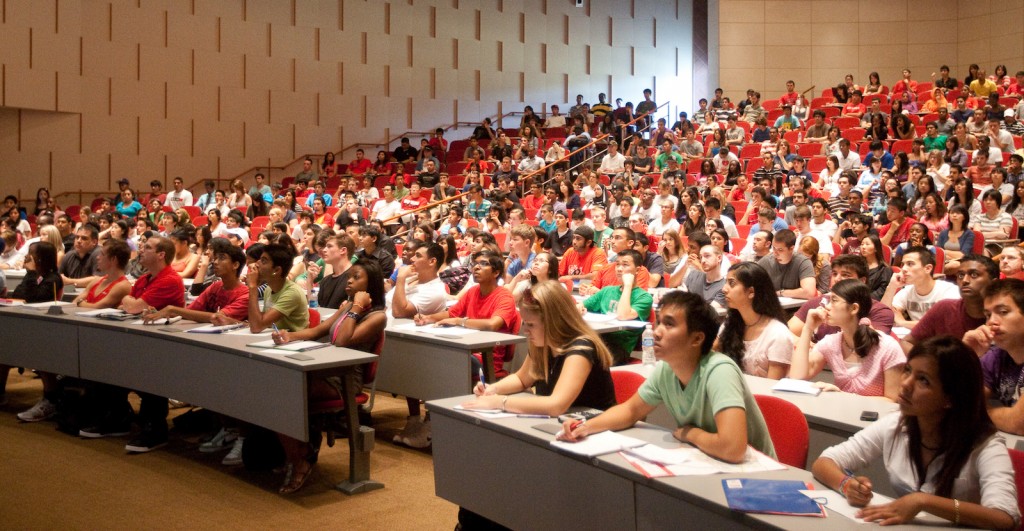You may have read Fast Company’s article back in May entitled “
This is the Future of College”. Alongside an intensifying focus on “skills, not semesters” and “a hybrid degree”, the “death of the lecture” was listed as one of the major changes taking place in an increasingly “project-based” curricula in many universities. This fall, there was a robust discussion that put the lecture under the microscope again. Here’s a rundown of some of the highlights.
It all started with the early September New York Times Sunday Review piece by Annie Murphy Paul, “Are College Lectures Unfair?” Paul argues on the back of a “growing body of evidence” that the college lecture is “a specific cultural form that favors some people while discriminating against others, including women, minorities and low-income and first-generation college students.” Because of this partiality, the lecture should be ditched in favor of a more “deliberately structured,” active-learning approach that encourages students to frequently contribute to discussion and debate in a “collaborative, low-pressure environment”.
Molly Worthen, assistant professor of history at the University of North Carolina, Chapel Hill, shot back in the New York Times Sunday Review by taking issue with the fact that lecturing is a passive activity. Instead, she argues, “absorbing a long, complex argument is hard work, requiring students to synthesize, organize and react as they listen.” By abandoning the lecture format, we do those who find absorbing a lecture difficult a great disservice by capitulating to “the worst features of the customer-service mentality that has seeped into the university from the business world.”
Damon Linker, senior correspondent at The Week, hails Worthen for taking the bold step in fighting back against proponents of “active,” “student-centered” learning. But Linker goes further by saying that, it’s not just the formal skills learned by students via the lecture process that justify the format, but rather that it’s the best, most efficient way to transmit the body of knowledge possessed by the lecturer.
Slate’s resident education columnist Rebecca Schuman was perhaps the first to respond negatively to Worthen by calling for professors not to focus on “ideal students” but rather to “include components designed for the average, real, very-much-not-ideal student they will actually meet.”
Derek Bruff, director of the Center for Teaching at Vanderbilt, adds a layer of nuance to the debate by focusing on what exactly we mean by lecturing. If what we mean by lecturing is “continuous exposition by the teacher,” then we have a less effective way to “promote thought, change attitudes, inspire interest, or teach skills.” However most lecturers, Bruff notes, do more than “continuous exposition” when teaching, including engaging students in discussion and interaction amidst their own well-timed exposition.
Adding to Bruff’s clarification, Josh Eyler from the Rice Center for Teaching Excellence, takes issue with Worthen’s either/or approach to classroom pedagogy. In a paragraph-by-paragraph analysis of the Worthen piece, Eyler argues that we need to take seriously the findings of many studies that prove Active learning methods work. At the very least, we need to entertain multimodal approaches. “[D]ifferent students,” he writes, “need different strategies in order to learn most effectively. If we approach education with a one-size-fits-all model, we are sure to fail our students.”
Adam P. Newman also takes issue as well with Worthen’s argument, but from the angle of students with disabilities, arguing that “universal design” and “flipped classrooms” might allow such students to “more fully engage and participate in their classrooms”. (Also, his Twitter-essay format is interesting in its own right.)
Finally, Elizabethe Barre argues that perhaps what underlies much of the active-learning vs. lecture argument isn’t really about pedagogy or research findings but rather about what it means to be a teacher at all. Whether we think of the teacher as “author” or as “tutor” will, according to Barre, predict fairly accurately which way we lean in this rapidly intensifying debate.
We would like to know what you think. What works best in your courses, a lecture format or an active learning approach, or something in between? Share your thoughts in the comments section below.





